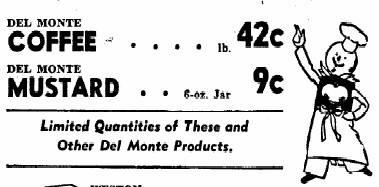
Waterloo (Iowa)
Daily Courier, Oct. 3, 1946
Thursday, January 20, 2005
Page 15
REMINISCING (Column)
Mustard: the Forgotten Product of Del Monte, Libby’s & Campbell’s
By ROGER M. GRACE
Among major food brands of today that included prepared mustard in the early days of the last century are Del Monte, Libby’s and Campbell’s. The funny thing is that the proprietors of those brands have blank spots in their institutional memories concerning their erstwhile mustard-making days.
In an e-mail sent in response to a query from me, a Del Monte Foods Company spokesperson said:
“We don’t have any records of a Del Monte Brand Mustard ever existing. We had a mustard relish item—it was typical pickle relish, but instead of the normal brine liquid, it was in diluted mustard liquid that was yellow in color and had mustard flavor. This wouldn’t have been considered mustard just a mustard flavored product.”
Yet, old newspaper ads show that Del Monte mustard did exist. The March 8, 1929 issue of the Reno (Nev.) Evening Gazette, for example, contained a grocery store ad offering three bottles of the product for a quarter. That beat the price of a self-service market in Helena, Mont., which, according to an ad in the Helena Independent on June 29, 1929, was charging the same price for two bottles.
|
|
|
Waterloo (Iowa)
Daily Courier, Oct. 3, 1946 |
|
The Evening Gazette on June 26, 1942 included a grocery store ad which offered 12-ounce jars of Del Monte Mustard for 10-cents each—the very price charged for a mere six-ounce jar at a market advertising in the Waterloo (Iowa) Daily Courier on Nov. 18, 1948.
As the king of Siam pronounced in “The King and I,” “et cetera, et cetera, et cetera.”
How can a company simply forget products it once manufactured? Simple. Unlike a family-owned business with continuity (like the McIlhenny Company that makes Tabasco Sauce), Del Monte has in recent years undergone transfers and transmutations.
The words “Del Monte” were first used in or about 1886 on a premium blend of coffee which a distributor packaged for the Hotel Del Monte in Monterey. In 1892, the distributor put the “Del Monte” name on canned peaches, and it’s that year which is generally used as the starting date for the brand.
The Del Monte Foods website recites:
“When eighteen West Coast canning companies merged in 1898 to form California Fruit Canners Association, Del Monte was one of several premium brands marketed by the new company. Then, in 1916, when CFCA consolidated its business with three other large canners to create California Packing Corporation—Del Monte Foods’ original Company name—the Del Monte brand took center stage. The new company’s strategy was to offer one high-quality brand, advertise nationally, and distribute products across the country.”
California Packing Corporation in 1931 gained from the United States Patent and Trademark Office a word mark on “Del-Monte” (spelled with a hyphen, since abandoned). Products listed for that brand in the application included mustard. (The mark was cancelled in 1996.)
|
|
|
|
U.S. Patent and Trademark Office |
|
In 1979, Del Monte was purchased by R.J. Reynolds, a tobacco company. A.1 Sauce and Grey Poupon Mustard, both subjects of previous columns, came under the dominion of Del Monte. But in 1985, R.J. Reynolds bought Nabisco, and Del Monte was now subordinated to that glitzier acquisition.
Then, in 1989, R.J. Reynolds separately sold the Del Monte canned goods products and the fresh produce business. That is to say, different, unrelated companies came to sell products bearing the Del Monte brand label, which continues today.
Libby’s, likewise, is a brand name that’s been cut into pieces. A spokesperson for ConAgra, the multi-national conglomerate that bought part of the Libby’s line of products from Nestles in 2000, said the purchase didn’t include prepared mustard. “I’m not sure what became of it,” he said.
The “Libby’s” name goes back to 1894. In 1986, Libby, McNeil and Libby sold its entire line to Nestles, a Swiss company. Actually, its name is Société des Produits Nestlé S.A.
Nestles still owns Libby’s pumpkin products.
|
|
|
|
Lethbridge (Alberta,
Can.) Herald, Nov. 17, 1949 |
|
The Campbell Soup Company came into existence in 1921, the new enterprise assuming the assets of the Joseph Campbell Company (the purchase price being $1). In essence, there was a continuation of the existing company, formed in 1876 by Campbell and by Arthur Dorrance.
According to the Campbell’s website, condensed soup became so popular that in 1905, the company ceased “manufacturing of preserves, jellies, jams, and fruit butter,” and in 1907 stopped making mincemeat, “focusing only on its best-selling and most profitable product: condensed soups.”
Wrong.
Ads in old newspapers show that both before 1905 and after 1907, Campbell’s was making prepared mustard, as well as salad dressing and baked beans.
|
A&P ad, Atlanta (Ga.) Constitution, Jan. 24, 1904
A&P
ad, Trenton
(N.J.) Evening Times, Oct. 7, 1909 |
|
Copyright 2005, Metropolitan News Company